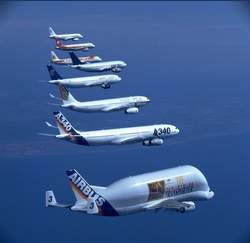Wed, Jun 18, 2003
 3D Systems Corp. announced just yesterday that
Airbus in the United Kingdom purchased an SLA® 7000 system to
produce components for wind tunnel testing at its operations in
Filton, Bristol. The purchase of an SLA 7000 system will be used to
create larger models with tighter tolerances and high quality
surface finish in the wind tunnel.
3D Systems Corp. announced just yesterday that
Airbus in the United Kingdom purchased an SLA® 7000 system to
produce components for wind tunnel testing at its operations in
Filton, Bristol. The purchase of an SLA 7000 system will be used to
create larger models with tighter tolerances and high quality
surface finish in the wind tunnel.
"My background for the last 5 years has been on the test side
where we are always under pressure to meet deadlines," said Martin
Aston wind tunnel domain manager for Airbus in Filton. "We were
already using 3D Systems technology through a third party service
bureau and were aware of some of the advantages of
stereolithography. If we are able to build models more quickly we
can enter the design cycle later, which gives the aerodynamicist
more time to think before committing to a test. We realized over a
year ago, rather than outsourcing our prototyping and model
production, that we needed to invest in new technology of our own
if we were going to improve our cycle times without lowering our
standards."
 "We are currently using the SLA 7000 system for
our Flight Physics which encompasses the aerodynamic groups who
submit new geometries for testing in the tunnel. Typical components
include leading edge and trailing edge configurations, flap tracks,
pylons and nacelles. Having our own SLA system on-site allows us to
react more quickly and more cost effectively to our bottom line,"
continued Aston. "We now try designs we never would have done
before because we have the technology on-site. Effectively we can
think of an idea, put it on the system to build overnight or over a
weekend and test it the next day. If the design doesn't work we
just repeat the process. To do that through a service bureau would
be almost impossible as the typical turnaround time is four
days."
"We are currently using the SLA 7000 system for
our Flight Physics which encompasses the aerodynamic groups who
submit new geometries for testing in the tunnel. Typical components
include leading edge and trailing edge configurations, flap tracks,
pylons and nacelles. Having our own SLA system on-site allows us to
react more quickly and more cost effectively to our bottom line,"
continued Aston. "We now try designs we never would have done
before because we have the technology on-site. Effectively we can
think of an idea, put it on the system to build overnight or over a
weekend and test it the next day. If the design doesn't work we
just repeat the process. To do that through a service bureau would
be almost impossible as the typical turnaround time is four
days."
Airbus has started experimenting with models that they would
never have attempted or thought possible previously. Producing
plastic models using the SLA system enables Airbus to cater for all
of the shapes and curves of aircraft components. Geometric form and
dimensional stability has been dramatically improved, which means
the test data is more accurate. By having the technology on-site a
deeper understanding of the process has been invaluable. This
knowledge allows the project coordinator to define and control
specific attributes of the geometry by understanding the
technology. They can then communicate these constraints with the
operator and part quality can be maintained.
"We no longer have the delay of waiting for returns if we need
to build a new iteration, we simply re-run it on the SLA system,"
stated Aston.
More News
“These new aircraft strengthen our ability to respond quickly, train effectively and support communities nationwide. Textron Aviation has been a steadfast supporter in helpin>[...]
From 2011 (YouTube Edition): Rugged, Legendary, STOL Twin Makes A Comeback The de Havilland Twin Otter is an airplane with a long history, and it gained a reputation as a workhorse>[...]
A Wind Gust Lifted The Right Wing And The Airplane Turned To The Left Analysis: The pilot was departing from a 2,395-ft-long by 50-ft-wide turf runway. The pilot reported that afte>[...]
Have A Story That NEEDS To Be Featured On Aero-News? Here’s How To Submit A Story To Our Team Some of the greatest new stories ANN has ever covered have been submitted by our>[...]
Braking Action Advisories When tower controllers receive runway braking action reports which include the terms “medium," “poor," or “nil," or whenever weather con>[...]
 Aero-News: Quote of the Day (12.18.25)
Aero-News: Quote of the Day (12.18.25) Classic Aero-TV: Viking Twin Otter 400--Bringing the DHC-6 Back Into Production
Classic Aero-TV: Viking Twin Otter 400--Bringing the DHC-6 Back Into Production NTSB Final Report: Rans Employee Flying Club Rans S-6ES Coyote II
NTSB Final Report: Rans Employee Flying Club Rans S-6ES Coyote II ANN FAQ: Submit a News Story!
ANN FAQ: Submit a News Story! ANN's Daily Aero-Term (12.18.25): Braking Action Advisories
ANN's Daily Aero-Term (12.18.25): Braking Action Advisories




